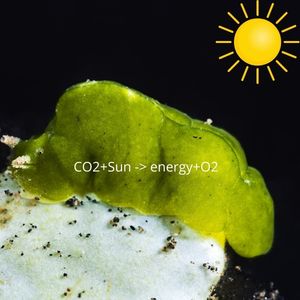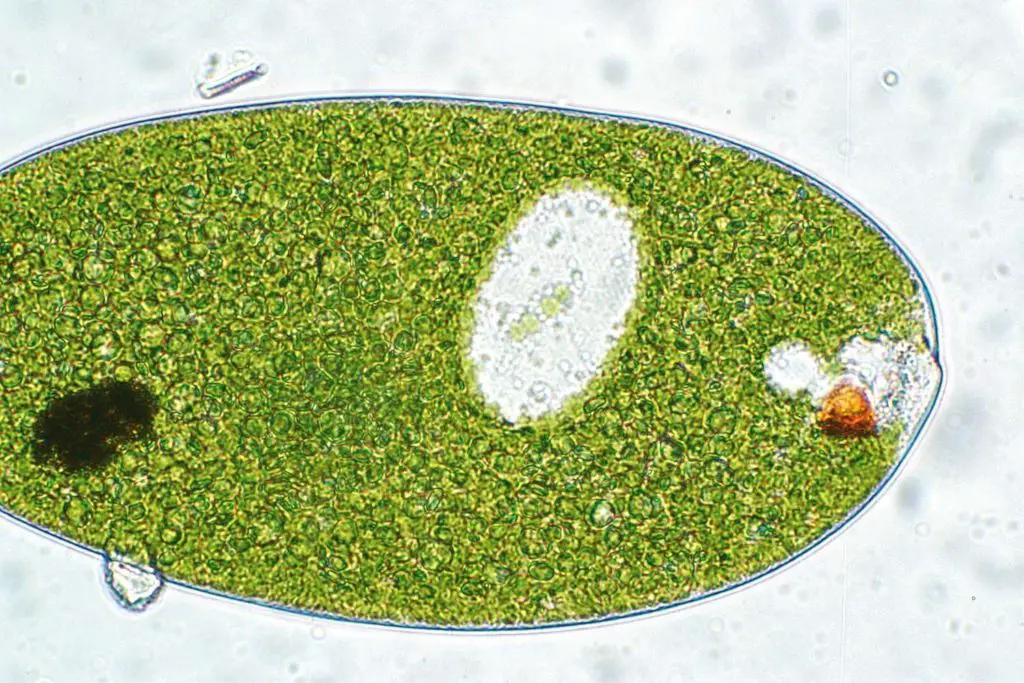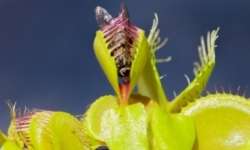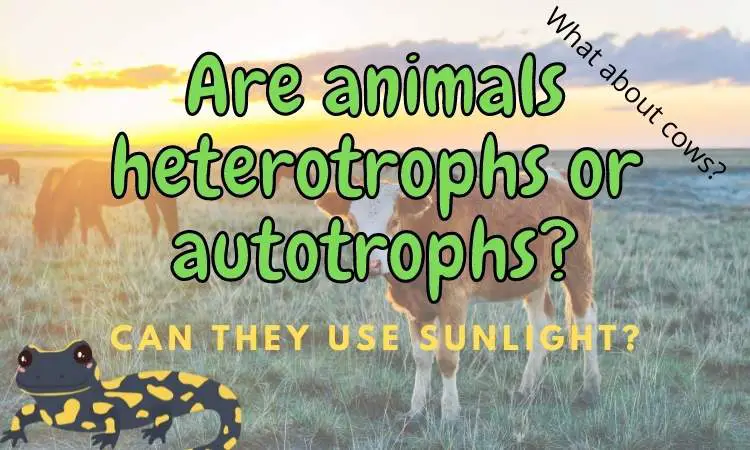Let’s dive a little bit into the energy metabolism of animals, and whether they can obtain energy from sunlight.
Animals are generally heterotrophs as (most, but not all, – see below!) animal cells lack chloroplasts to perform photosynthesis. Animals get their energy from eating organic compounds in the form of other organisms like plants, other animals, or microorganisms.
There are many different types of organisms in the world, and they can be classified by how they acquire energy. There are two main types: autotrophic and heterotrophic.
Autotrophs are able to photosynthesis to produce their own food, while heterotrophs must eat other organic matter to gain energy.
In this blog post, we will explore the differences between these two types of organisms and discuss some examples of each!
I took on this topic because there are some common misconceptions and some very fascinating examples of (almost) autotrophic animals that we need to talk about!
The word heterotroph is derived from two Greek words: the first meaning other, and the second meaning feeder. Generally speaking, heterotrophs feed on other organisms, which explains their name.
Heterotrophs are also known as “consumers.” This is because they consume other organic matter in order to gain energy. They cannot photosynthesize to produce their own food.
So the rule of thumb is that all animals are heterotrophs. This can sometimes seem a bit unfair, as plants also have mitochondria, on top of their chloroplasts, that allow them to “feed” as heterotrophs as well.
Anyways, there are examples of animals that have evolved a so close collaboration with photosynthetic algae, that they can benefit directly from their autotrophic energy generation!
Contents
Are any Animals Autotrophs?
While it is not common for animals to obtain any form of energy from the sun, there are indeed examples of fascinating symbiotic relationships in slugs, aphids, and salamanders that are as close as we get to actual photosynthetic animals:
The spotted salamanders are the only vertebrate that can perform photosynthesis.

It is an extremely fascinating example of how two organisms have merged on the cellular level – a bit like the way our cells have evolved according to the endosymbiont theory!
How do spotted salamanders use photosynthesis?
It was discovered that the fetuses of spotted salamanders have a symbiotic relationship with certain algae that live in oxygen-poor ponds. This relationship, where the algae supply oxygen, allows the salamander eggs to survive despite the lack of oxygen.
It was long thought that these algae were just present outside the cells of the salamander, but it has now been discovered that the algae live inside the salamander’s cells – and stay inside the cells even in adult salamanders!
This symbiosis allows the salamander to obtain a substantial amount of energy from the sun.
Alien sea slugs use algae DNA to make energy from the sun!

Another interesting example is the Sea Slug (Elysia chlorotica) which lives primarily from algae on the ocean floor. However, due to its crude digestion, it has managed to merge the DNA used for photosynthesis in algae with its own DNA (a process known as horizontal gene transfer).
This is even more extreme than the salamander because the sea slug actually becomes truly photosynthetic and does not just depend on collaboration with other autotroph organisms like the spotted salamander!
This means that the sea slug will not only be able to perform photosynthesis, but also pass it on to its offspring!
Euglena – the versatile microbe!
Actually, there are also microscopic animals with autotrophic capabilities. The most interesting ones are Euglena, which is a group of microbes that are not quite animals and not quite plants.

But they do have chloroplasts which give them the ability to live on energy from the sun! Although they do prefer to eat bacteria and other organic compounds floating around them.
If you are interested in knowing more about how and when Euglena obtain their energy, take a look at my latest article on Euglena here.
What is the difference between photosynthesis and respiration?
Photosynthesis and respiration are two different ways that organisms can acquire energy. Photosynthesis is the process of producing food from sunlight, water, and carbon dioxide. Respiration is the process of breaking down food to release energy.
In photosynthesis, energy from the sun is used to produce glucose from carbon dioxide and water. In respiration, glucose is broken down to release energy.
Respiration is the performed by all living organisms that use oxygen – even plants do it!
Is a cow an autotroph or heterotroph?
Let’s look at a familiar example, the cow, as an animal obtaining its energy from other organisms, however, perhaps exactly what you might think (hint: they do not get their energy directly from grass or hay!).
Because of their diet, cows and other animals are known as heterotrophs. This means that they cannot make energy from the sun like plants and some bacteria, because they get their energy from the food that they eat.
It does not, however, explain how such organisms get food: for this, you need to look at the digestive system of the cow as well!
Why are cows heterotrophs?
Cows are heterotrophs because, like (almost) all animals, they can only get their energy from the food they eat. This simple but important fact is not always well accepted.
This is in contrast to autotrophs like plants and algae, which mainly get their energy from the sun.
How do cows get their nutrients and energy?
So you have probably heard that animals such as cows, sheep, and deer are ruminants.
Cows are a typical example of a ruminant, meaning they have a four-chambered stomach. But how does that all work?
The first step in getting around the tough grass is to chew it into a pulp. The crook of the cow’s mouth has tough tissue that helps with this. Then, when the cow swallows that pulp, it’s sent down to its 4-chambered stomach (rumen).

In there, bacteria break down the grass into fatty acids and other things that the cow can more easily digest.
Once this process is complete, the cow will regurgitate its food as cud and chew it again before swallowing it all over again to continue breaking it down.
The cow’s first chamber is the rumen, where all of the grass goes to be broken down by bacteria. The bacteria in the rumen helps break down the grass into fatty acids, that can be easily absorbed through the cow’s stomach wall and intestines.
These fatty acids end up in the bloodstream of the cow and is in fact its primary energy source! So cows actually live on fat and dying bacteria, not grass!
Now, wait a second, you’re probably thinking, how is this better than just eating the grass directly?
Good question. But animals can’t digest cellulose, the main component of grasses, but bacteria find it delicious!
Bacteria break cellulose down into simple sugars that they then use for their own energy. But because there is no oxygen present they end up producing “waste products” in the form of short-chained fatty acids such as lactic acid (just like when your muscles lack oxygen during exercise!).
It is somewhat the same principle as incomplete combustion of a car engine – it really smells because it leads to lots of unreacted gasoline breakdown products in the air!
A downside of the bacterial digestion process in cows is the production of methane, which is a strong greenhouse gas! And farts that smell…
why are mushrooms considered heterotrophic organisms?
Mushrooms are heterotrophic organisms because they cannot photosynthesize to produce their own food. Instead, they rely on other organic matter to survive. This can include things like decaying logs or plants.
Because mushrooms, and other fungi, consume mostly death and decaying matter they are also called decomposers. Decomposers play an important role in the environment by breaking down dead material and returning its nutrients to the soil. This helps to keep ecosystems healthy!
Is a dolphin a heterotroph or an autotroph?
A dolphin is a heterotroph. This means that it must consume other organic matter in order to gain energy. Dolphins cannot photosynthesize to produce their own food. Instead, they eat fish and other small creatures in the ocean.
Are plants autotrophic or heterotrophic?
All plants are autotrophic. This means that they photosynthesis to produce their own food. Plants do not consume other organic matter in order to gain energy. Instead, they use photosynthesis to produce glucose, which they use as food. This makes them the primary producers in most ecosystems!
However, because plants do have mitochondria they can also perform respiration and thereby use glucose for energy.
Is a venus fly trap an autotroph or a heterotroph?
A Venus Fly Trap is a carnivorous plant that can perform photosynthesis like other plants. Therefore Venus fly traps are autotrophic even though it is also able to digest insects for nutrients.

The reason that carnivorous plants are still considered autotrophic is that they can survive on energy from sunlight alone without eating anything.
However, these carnivorous plants often live in nutrient-poor soils, and therefore supplementing the sparse soil nutrients with the proteins and minerals of insects is a huge benefit that makes it grow bigger more easily. I bit like vitamin pills work for us humans!
Why is photosynthesis beneficial for both autotrophs and heterotrophs?
Photosynthesis is beneficial for both autotrophs and heterotrophs because it allows them to acquire energy in different ways.
Autotrophs can photosynthesis to produce their own food, while heterotrophs must eat other organic matter to gain energy.
In this way, autotrophs channel energy up through the food chain. The energy they they received from the sun!
So essentially all life forms get their energy from the sun directly or indirectly! Perhaps with the exception of some chemotrophic bacteria…
This makes photosynthesis a very important process for both types of organisms!
Are blepharisma autotrophic or heterotrophic?
Blepharisma are heterotrophic protozoan organisms because they do not have chloroplasts, so they need to consume organic matter.
I am not going much deeper into blepharisma is I have written a whole blog post about their diet that answers if they can be autotrophic or not.
They are found in both marine and freshwater environments. Some photosynthetic bacteria, such as cyanobacteria, can also be heterotrophic when food is scarce.
Are viruses autotrophic or heterotrophic?
Viruses are heterotrophic because they rely on other cells to reproduce. They cannot photosynthesize or produce their own food.
They also do not have a cell wall, similar to most animals, if you’re interested.




